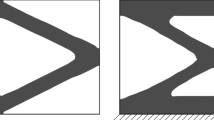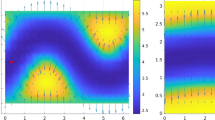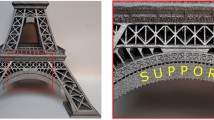Abstract
The paper presents a formulation for simultaneous optimization of part and support in additive manufacturing. A pseudo heat conduction problem is solved to simulate heat transfer between the part and support. In the pseudo problem, a surface slope-dependent heat flux is applied on the part/support interfaces. The input heat is then transferred through the part and support to the build plate, which is treated as the heat sink. Since the density-based topology optimization does not involve explicit surface representation, the heat flux is implicitly imposed through a domain integration of a Heaviside projected density gradient. The proposed formulation has the inherent ability to control surface slope, which allows us to obtain self-supported enclosed voids and put removable external supports only on the open surfaces. Self-supporting supports can also be obtained by controlling the anisotropic thermal conductivity of the supports. Three different objective functions related to heat dissipation efficiency of the support are investigated. Both 2D and 3D numerical examples are presented to demonstrate the validity and efficiency of the proposed approach.




















Similar content being viewed by others
References
Allaire G, Bogosel B (2018) Optimizing supports for additive manufacturing. Struct Multidisc Optim 58(6):2493–2515
Allaire G, Dapogny C, Estevez R, Faure A, Michailidis G (2017) Structural optimization under overhang constraints imposed by additive manufacturing technologies. J Comput Phys 351:295–328
Bendsøe MP (1989) Optimal shape design as a material distribution problem. Struct Optim 1(4):192–202
Bendsøe MP, Sigmund O (2003) Topology optimization—theory, methods and applications, 2nd edn. Springer, Berlin
Cheng L, Liang X, Bai J, Chen Q, Lemon J, To A (2019) On utilizing topology optimization to design support structure to prevent residual stress induced build failure in laser powder bed metal additive manufacturing. Addit Manuf 27:290–304
Clausen A, Aage N, Sigmund O (2015) Topology optimization of coated structures and material interface problems. Comput Methods Appl Mech Eng 290:524–541
Clausen A, Aage N, Sigmund O (2016) Exploiting additive manufacturing infill in topology optimization for improved buckling load. Engineering 2(2):250–257
Clausen A, Andreassen E, Sigmund O (2017) Topology optimization of 3D shell structures with porous infill. Acta Mech Sin 33:1–14
Gaynor AT, Guest JK (2016) Topology optimization considering overhang constraints: eliminating sacrificial support material in additive manufacturing through design. Struct Multidisc Optim 54(5):1157–1172
Gaynor AT, Meisel NA, Williams CB, Guest JK (2014) Topology optimization for additive manufacturing: considering maximum overhang constraint. In: 15th AIAA/ISSMO multidisciplinary analysis and optimization conference, p 2036
Gibson I, Rosen D, Stucker B (2014) Additive manufacturing technologies: 3D printing, rapid prototyping, and direct digital manufacturing. Springer, New York
Guo X, Zhou J, Zhang W, Du Z, Liu C, Liu Y (2017) Self-supporting structure design in additive manufacturing through explicit topology optimization. Comput Methods Appl Mech Eng 323:27–63
Haber RB, Jog CS, Bendsøe MP (1996) A new approach to variable-topology shape design using a constraint on perimeter. Struct Optim 11(1–2):1–12
Jiang J, Xu X, Stringer J (2018) Support structures for additive manufacturing: a review. J Manuf Mater Process 2(4):64
Keller N, Ploshikhin V (2014) New method for fast predictions of residual stress and distortion of AM parts. In: Solid freeform fabrication symposium, 2014, vol 25
Kuo Y-H, Cheng C-C, Lin Y-S, San C-H (2018) Support structure design in additive manufacturing based on topology optimization. Struct Multidisc Optim 57(1):183–195
Langelaar M (2016a) An additive manufacturing filter for topology optimization of print-ready designs. Struct Multidisc Optim 55:1–13
Langelaar M (2016b) Topology optimization of 3D self-supporting structures for additive manufacturing. Addit Manuf 12:60–70
Langelaar M (2018) Combined optimization of part topology, support structure layout and build orientation for additive manufacturing. Struct Multidisc Optim 57(5):1985–2004
Lazarov BS, Sigmund O (2011) Filters in topology optimization based on Helmholtz-type differential equations. Int J Numer Methods Eng 86(6):765–781
Lazarov BS, Alexandersen J, Sigmund O (2014) Topology optimized designs of steady state conduction heat transfer problems with convection boundary conditions. In: EngOpt, 2014
Liang X, Cheng L, Chen Q, Yang Q, To AC (2018) A modified method for estimating inherent strains from detailed process simulation for fast residual distortion prediction of single-walled structures fabricated by directed energy deposition. Addit Manuf 23:471–486
Liu S, Li Q, Chen W, Tong L, Cheng G (2015) An identification method for enclosed voids restriction in manufacturability design for additive manufacturing structures. Front Mech Eng 10(2):126–137
Logg A, Mardal K-A, Wells G (2012) Automated solution of differential equations by the finite element method: the FEniCS book, vol 84. Springer, Berlin
Luo Y, Sigmund O, Li Q, Liu S (2020) Additive manufacturing oriented topology optimization of structures with self-supported enclosed voids. Comput Methods Appl Mech Eng 372:113385
Mezzadri F, Qian X (2020) A second-order measure of boundary oscillations for overhang control in topology optimization. J Comput Phys 410:109365
Mezzadri F, Bouriakov V, Qian X (2018) Topology optimization of self-supporting support structures for additive manufacturing. Addit Manuf 21:666–682
Mirzendehdel AM, Suresh K (2016) Support structure constrained topology optimization for additive manufacturing. Comput Aided Des 81:1–13
Morgan HD, Cherry JA, Jonnalagadda S, Ewing D, Sienz J (2016) Part orientation optimisation for the additive layer manufacture of metal components. Int J Adv Manuf Technol 86(5–8):1679–1687
Qian X (2017) Undercut and overhang angle control in topology optimization: a density gradient based integral approach. Int J Numer Methods Eng 111(3):247–272
Reza EM, Hetnarski RB, Ignaczak J, Noda N, Sumi N, Tanigawa Y (2013) Theory of elasticity and thermal stresses, vol 197. Springer, Dordrecht
Sigmund O, Maute K (2013) Topology optimization approaches. Struct Multidisc Optim 48(6):1031–1055
Stegmann J, Lund E (2005) Discrete material optimization of general composite shell structures. Int J Numer Methods Eng 62(14):2009–2027
Svanberg K (1987) The method of moving asymptotes—a new method for structural optimization. Int J Numer Methods Eng 24(2):359–373
van de Ven E, Maas R, Ayas C, Langelaar M, van Keulen F (2018) Continuous front propagation-based overhang control for topology optimization with additive manufacturing. Struct Multidisc Optim 57(5):2075–2091
Wang C (2020) Boundary control in multiphysics topology optimization for advanced manufacturing. PhD Thesis
Wang C (2022) Simultaneous optimization of build orientation and topology for self-supported enclosed voids in additive manufacturing. Comput Methods Appl Mech Eng 388:114227
Wang C, Qian X (2020a) Simultaneous optimization of build orientation and topology for additive manufacturing. Addit Manuf 34:101246
Wang C, Qian X (2020b) A density gradient approach to topology optimization under design-dependent boundary loading. J Comput Phys 411:109398
Wang C, Qian X (2020c) Optimizing support for heat dissipation in additive manufacturing. In: ASME 2020 international design engineering technical conferences and computers and information in engineering conference, 2020. American Society of Mechanical Engineers Digital Collection
Wang Y, Gao J, Kang Z (2018) Level set-based topology optimization with overhang constraint: towards support-free additive manufacturing. Comput Methods Appl Mech Eng 339:591–614
Wang C, Qian X, Gerstler WD, Shubrooks J (2019) Boundary slope control in topology optimization for additive manufacturing: for self-support and surface roughness. J Manuf Sci Eng 141(9):091001
Wang C, Zhang W, Zhou L, Gao T, Zhu J (2021) Topology optimization of self-supporting structures for additive manufacturing with B-spline parameterization. Comput Methods Appl Mech Eng 374:113599
Wang C, Yu Z, Zhou M, Qian X (2022) Topology optimization of thermophotonic problem for daytime passive radiative cooling. Int J Heat Mass Transf 183:122097
Xu S, Cai Y, Cheng G (2010) Volume preserving nonlinear density filter based on Heaviside functions. Struct Multidisc Optim 41(4):495–505
Yamada T, Izui K, Nishiwaki S (2011) A level set-based topology optimization method for maximizing thermal diffusivity in problems including design-dependent effects. J Mech Des 133(3):031011
Zhang K, Cheng G (2020) Three-dimensional high resolution topology optimization considering additive manufacturing constraints. Addit Manuf 35:101224
Zhang W, Zhou L (2018) Topology optimization of self-supporting structures with polygon features for additive manufacturing. Comput Methods Appl Mech Eng 334:56–78
Zhang K, Cheng G, Liang X (2019) Topology optimization considering overhang constraint in additive manufacturing. Comput Struct 212:86–100
Zhou M, Rozvany GIN (1991) The COC algorithm, Part II: topological, geometrical and generalized shape optimization. Comput Methods Appl Mech Eng 89(1–3):309–336
Zhou M, Liu Y, Lin Z (2019) Topology optimization of thermal conductive support structures for laser additive manufacturing. Comput Methods Appl Mech Eng 353:24–43
Funding
The work was supported by National Natural Science Foundation of China (No. 12102375) and Independent Innovation Foundation of AECC (No. ZZCX-2018-017).
Author information
Authors and Affiliations
Corresponding author
Ethics declarations
Conflict of interest
The authors declare that they have no conflict of interest.
Ethical approval
This article does not contain any studies with human participants or animals performed by any of the authors.
Replication of results
All results in the manuscript are obtained in the open-source finite element platform FEniCS. The necessary information for replicating the results has been presented in the manuscript. The readers can contact the corresponding author for further implementation details.
Additional information
Responsible Editor: Zhen Luo
Publisher's Note
Springer Nature remains neutral with regard to jurisdictional claims in published maps and institutional affiliations.
An earlier version of this paper appeared in the 2020 ASME International Design Engineering Technical Conferences and the PhD Thesis of the first author.
Rights and permissions
Springer Nature or its licensor (e.g. a society or other partner) holds exclusive rights to this article under a publishing agreement with the author(s) or other rightsholder(s); author self-archiving of the accepted manuscript version of this article is solely governed by the terms of such publishing agreement and applicable law.
About this article
Cite this article
Wang, C., Qian, X. Simultaneous optimization of part and support for heat dissipation in additive manufacturing. Struct Multidisc Optim 66, 3 (2023). https://doi.org/10.1007/s00158-022-03466-9
Received:
Accepted:
Published:
DOI: https://doi.org/10.1007/s00158-022-03466-9




